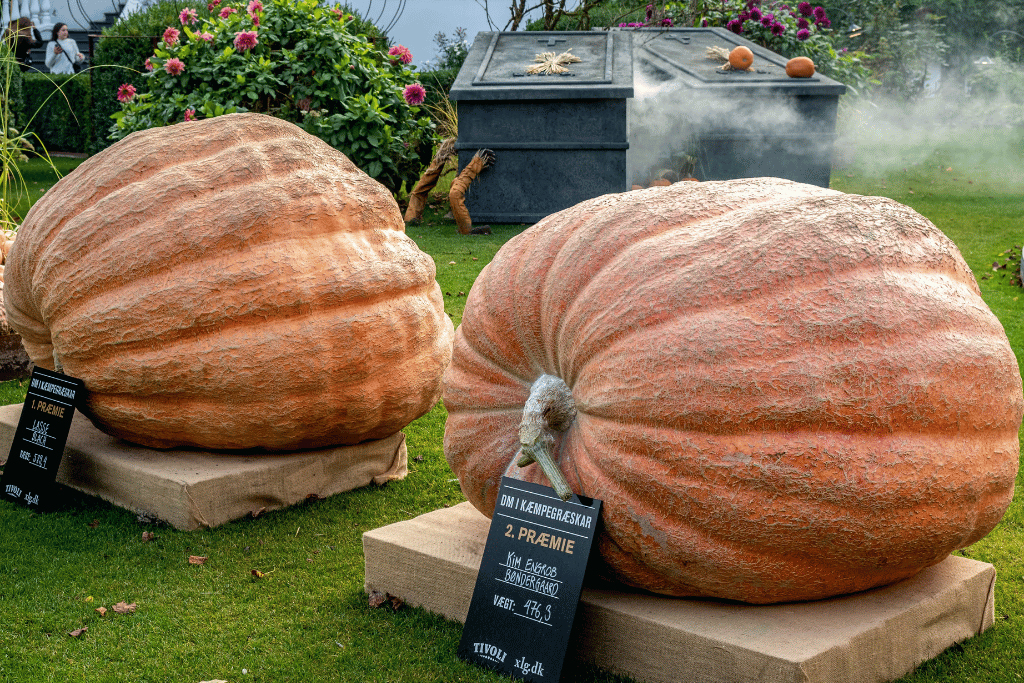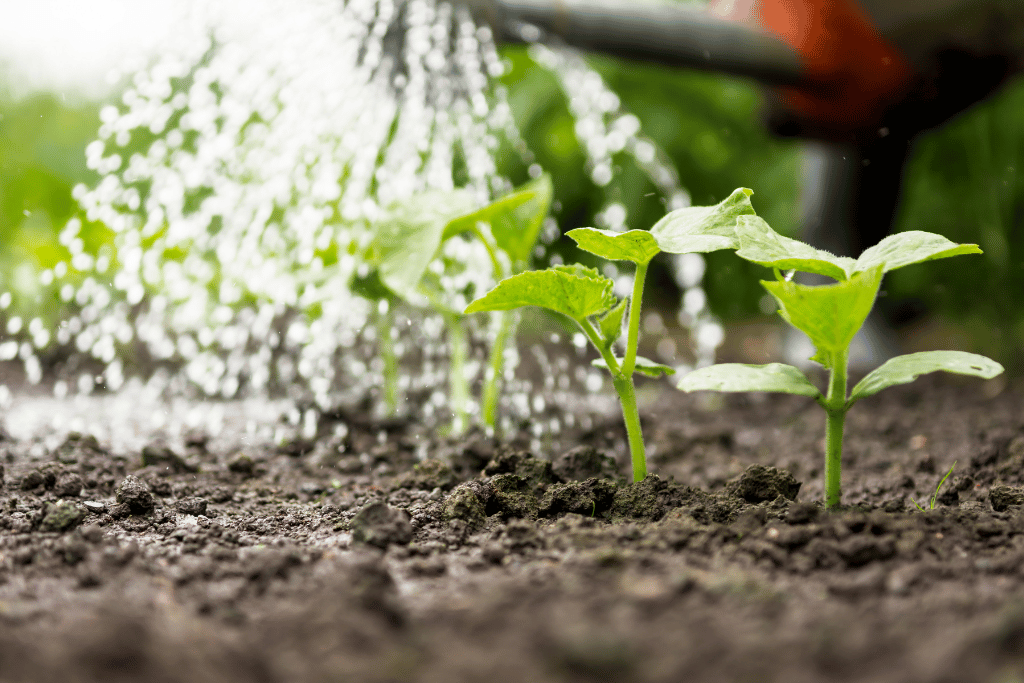
Pumpkins are a beloved symbol of autumn, and their cheerful orange hue and versatile uses make them a popular crop for gardeners. But just how many pumpkins per plant can you expect to harvest? Let’s solve this puzzle together as we explore the intricacies of different varieties and ways to maximize your yield!
How Many Pumpkins Per Plant Are Advised To Aim For

Your goal for the number of pumpkins to grow on each plant boils down to your purpose for cultivating them. Let’s suppose you’re keen on growing a colossal pumpkin variety, like the famed Mammoth Gold. To achieve the most impressive specimen, you’ll want to dedicate all your resources to that single gourd.
However, if you prefer a more typical pumpkin size, such as the charming Sweet Lightning variety, targeting 2 per plant will yield the finest results.
The key takeaway here is to avoid cramming your pumpkin plants together, as they’ll end up vying for essential resources. A widely accepted guideline for standard pumpkin cultivation is 3 per plant. Exceeding this can lead to congestion and may compromise the quality when harvest time rolls around.
Effective pumpkin cultivation is all about the vines. These climbers require ample space to stretch, crawl, expand, and breathe. You can encourage this by growing your round pals on a pumpkin on trellis. Therefore, the more fruits you grow per plant, the more real estate the vines will demand. Overcrowding results in a scarcity of resources, ultimately leaving all the gourds on a vine famished.
The Number Of Pumpkins Per Plant Depends On The Size
Mini Pumpkins

Miniature pumpkin varieties typically produce 3 to 6 fruits on each plant, but this can vary depending on growing conditions and the specific cultivar. For example, the Baby Boo pumpkin usually bears 3-5 teeny white fruits per vine, while the Jack Be Little type can pop out up to 10 small fruits. Other popular choices include the Munchkin pumpkin which grows a maximum of 6 fruits. To ensure a bountiful harvest, it’s essential to provide these greens with adequate sunlight, water, and nutrients. With proper care and attention, you can enjoy a gorgeous collection of ornamental and culinary greenery and see how many mini pumpkins per plant your chosen cultivar produces.
Small Pumpkins

One of the most well-known small pumpkin varieties is the Sugar Pie, which usually bears 2-3 fruits on each plant. How many pie pumpkins per plant you can expect to grow can greatly depend on the variety and growing conditions. A rather regular-sized specimen like the Sugar Pie weighs between 5 to 8 pounds (approximately 2-3.5 kg) and is perfect for baking pies. In addition, other similar pumpkins include Cinderella, New England Pie, and Baby Pam. Each of them yields 2-3 fruits weighing around 4 to 6 pounds (about 1.8-2.8 kg). More plentiful types in this category like the Acorn squash and Spaghetti squash are able to bear up to 6 fruits. With the right treatment, these small pumpkin varieties allow for an abundant harvest of delicious and festive specimens for fall cooking and decoration.
Large Pumpkins

There are some truly gigantic types of pumpkin that mostly only produce one or a maximum of two fruits on each plant. So, it’s not much of a mystery how many Big Max pumpkins per plant you can expect for example, as most of the time this monstrous gourd boasts a single fruit of up to 100 pounds (45 kg) or even more.
Other enormous varieties include the Atlantic Giant and the Prizewinner with even larger produce of up to 200 pounds (90 kg) or more, but this usually means a single fruit. It’s worth noting that these jumbo pumpkins have a wide range of uses beyond decorating or carving, such as culinary applications and competitive growing.
Fun fact: The largest pumpkin ever recorded weighed a whopping 2.624 pounds (almost 1.190 kg), surpassing the previous record holder by over 100 pounds.
How To Plant Pumpkins To Maximize Yield

There are a few key tips to follow to get the most out of your harvest. First, choose a location with full sun and well-draining soil. Next, plant the pumpkin seeds directly into the ground once the soil temperature reaches at least 60°F (15°C).
Make sure to space the pumpkins at least 6 feet (about 1.8 meters) apart in rows that are 8-10 feet (2.5-3 meters) apart. Row planting will give the vines enough space to spread out and allow for maximum sunlight exposure. When the vines start to grow, train them to move in a circular pattern around the base of the plant, which will help to distribute nutrients more evenly and prevent the vines from getting tangled. You can easily manage to create a circular pattern by gently encouraging the vine to spiral around the base of the plant as it develops. As the vine gets longer, you can use small stakes or twine to softly guide it in the desired direction. Be sure to not tie the vine too tightly, as this could damage or break it. Continue to monitor its growth and adjust the tools as needed.
Finally, pay attention to keeping the soil consistently moist and fertilize regularly with a balanced product. With these tricks, you should be able to collect healthy specimens to be utilized for your desired purpose.
Pumpkin Companion Planting For A Successful Harvest

Companion planting is a great way to boost the growth and yield of your pumpkins. For smaller varieties like sugar pumpkins, try planting them alongside marigolds or nasturtiums. This method could have a serious influence on how many sugar pumpkins per plant you’ll be able to gather. The aforementioned flowers attract beneficial insects like ladybugs and lacewings that will help control pest populations.
For larger gourds like Atlantic Giants, consider placing them near corn, beans, or sunflowers. Taller plants provide shade and support for the pumpkin vines as they get bigger and longer, and also contribute to conserving soil moisture. Additionally, pumpkins grown alongside corn can benefit from the nitrogen-fixing bacteria that live on corn roots. Finally, don’t forget to add some herbs like basil or oregano nearby – these are excellent at repelling pets and improving the flavor of your pumpkins!
Plants To Avoid Pairing Up Your Pumpkins With
While companion planting pumpkins is certainly an advantageous technique, it’s crucial to highlight that there are a couple of plants you want to avoid when choosing your squash a neighbor. For instance, potatoes are not suitable mates because they belong to the same family as pumpkins, the cucurbit family. Cultivating members of the same family in close proximity increases the risk of the spread of diseases and pests that affect both plants.
Moving on, it’s indispensable to mention that onions have the ability to stunt the growth of pumpkins since they release sulfurous compounds into the soil that potentially inhibit the development of nearby gourds.
How many pumpkins do you get per plant if you place beets next to them? Well, probably fewer. Beets are just as heavy feeders as pumpkins and thus may deplete the soil of valuable nutrients that gourds need to grow properly.
Last, but not least, greenery in the brassica family, such as broccoli, kale, and cabbage, are not to be left next to pumpkins either because they’ll all end up competing for food in the ground. In addition, chances are broccoli and its counterparts attract pests like aphids that might spread to pumpkins and inflict damage.
How Much Time It Takes For Pumpkins To Mature
- Miniature pumpkins, such as Jack Be Little, typically take 80-100 days to ripen.
- Standard-sized squashes, such as Cinderella, usually require 90-110 days to mature.
- Large pumpkins, such as Mammoth Gold need 120-140 days to be ready for being harvested.
Factors like weather, soil quality, and sunlight exposure heavily impact the growth and ripening process of pumpkins.
Also, it’s essential to monitor your plants on a regular basis and gather them when they’re fully mature for the best flavor and longevity.
Final Words
It’s easy to get caught up in the numbers when it comes to pumpkin growing, but remember that the procedure itself is just as important. Take pride in the effort you put into your garden, and enjoy the fruits of your labor, no matter how many pumpkins per plant you end up with.
Frequently Asked Questions (FAQ)
hat happens if pumpkins grow too close to one another?
When pumpkins are planted too closely together, they engage in a struggle for resources like sunlight, nutrients, and water. This competition leads to smaller fruit, stunted growth, and greater vulnerability to diseases and pests. To avoid this, it is advised to leave a distance of 3-5 feet between pumpkin plants for optimal growth and yield.
How do you encourage pumpkin growth?
To promote the development of pumpkins, they should be given sufficient space, regular watering, fertile soil that is free of weeds and pests, and plenty of sunlight. Additionally, supporting them with a balanced fertilizer high in nitrogen or compost to the soil also proves to be useful. If needed, hand pollination can be done, and mature fruits should be harvested promptly.
Why is only one pumpkin growing?
In case you ended up with one single pumpkin but counted on more, circumstances like inadequate pollination, poor soil quality, or overcrowding of the plant are to blame. Plus, it’s vital to know that certain varieties will only bear a single fruit. Generally, to grow multiple gourds, it’s significant to provide proper care, including enough sunlight, water, nutrients, and space for the plant to thrive.



